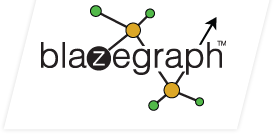Main_Page

Blazegraph™ DB is a ultra high-performance graph database supporting Blueprints and RDF/SPARQL APIs. It supports up to 50 Billion edges on a single machine. It is in production use for Fortune 500 customers such as EMC, Autodesk, and many others. It is supporting key Precision Medicine applications and has wide-spread usage for life science applications. It is used extensively to support Cyber anaytics in commercial and government applications. It powers the Wikimedia Foundation's Wikidata Query Service.
The Blazegraph product covers all application needs starting from small applications with embedded storage, to larger standalone applications, and up to 50B statements stored in NanoSparqlServer. There are different operating modes (triples, provenance, and quads), and 100s of configuration options.
You can choose an executable jar, war file, or tar.gz distribution.
After you've downloaded it, checkout out our quick start guide and sample applications. Once you've started development, the Blazegraph Community is the best way for us to assist in your design and development. Support is available via the Github Issues and JIRA issue tracker.
